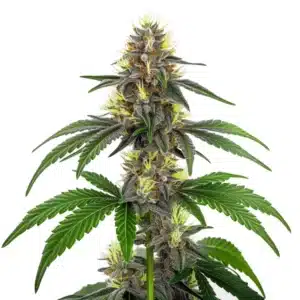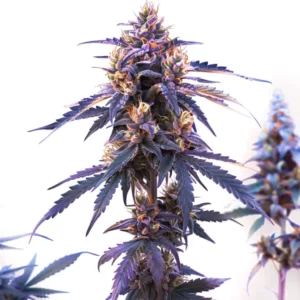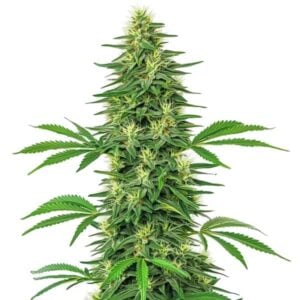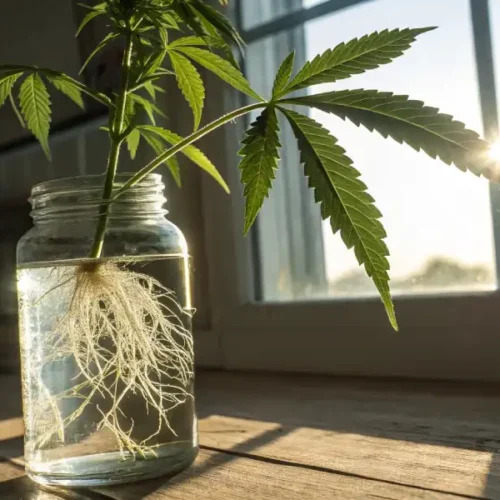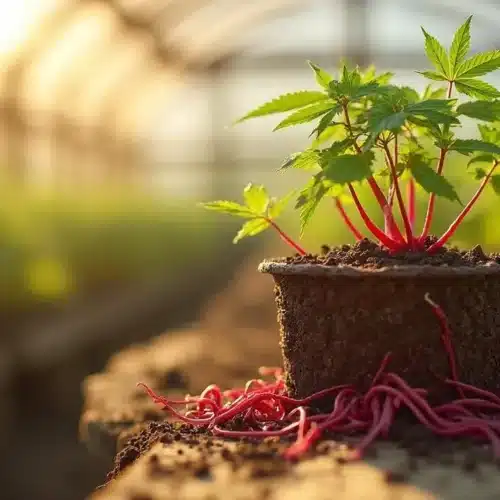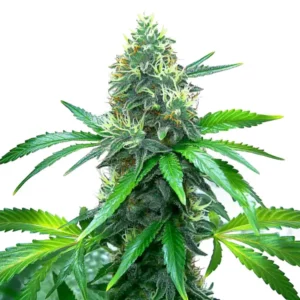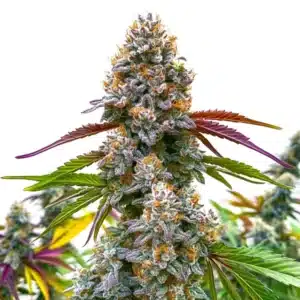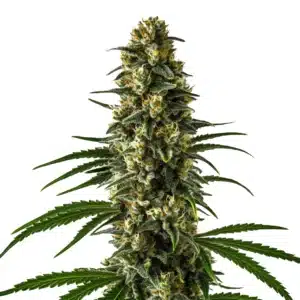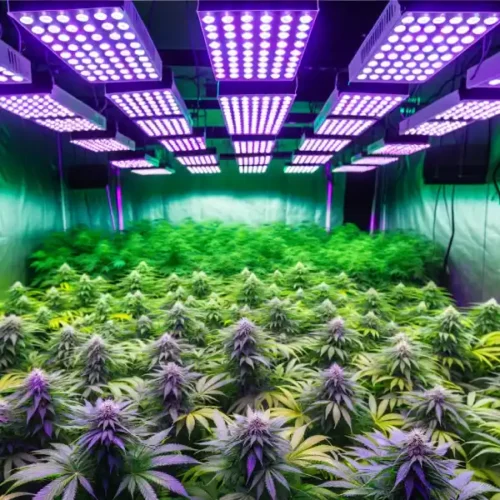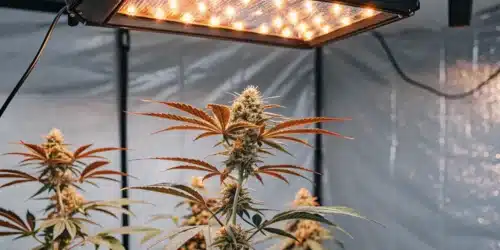When it comes to growing top-quality marijuana, the right grow lights are an absolute game-changer. Whether you’re a novice grower just starting out or a seasoned cultivator looking to refine your technique, choosing the best grow lights for marijuana is critical to achieving the lush, potent harvests you’ve always dreamed of. In this comprehensive guide, we’ll explore what makes a grow light truly exceptional, focusing on the essential features and specifications that can elevate your cannabis cultivation to new heights.
Why Grow Lights Are Crucial for Marijuana Cultivation
Grow lights are not just a supplemental element in indoor marijuana cultivation—they are the lifeblood of your grow operation. Without the right lighting, even the best seeds and the most carefully managed grow environment will fail to produce the dense, resinous buds that cannabis growers strive for.
How Light Drives Cannabis Development
To comprehend why selecting the best grow lights for marijuana is so important, you need to grasp the fundamental role that light plays in the growth process. Light is the primary energy source for plants. Through photosynthesis, marijuana plants convert light into the energy they need to grow, develop buds, and produce cannabinoids. The quality, intensity, and duration of light your plants receive directly affect their growth rate, health, and yield.
Grow lights are designed to mimic the natural sunlight that outdoor plants would receive, providing the necessary spectrum of light that cannabis plants need throughout their life cycle. Different wavelengths of light are crucial at various stages of growth—for instance, blue light promotes vegetative growth, while red light encourages flowering. Without the proper spectrum and intensity, your marijuana plants may struggle to reach their full potential, leading to lower yields and less potent buds.
How Light Quality and Intensity Influence Yield and Potency
The impact of grow lights on marijuana yield and potency cannot be overstated. Light intensity, measured in lumens or PAR (Photosynthetically Active Radiation), directly correlates with the size and density of your buds. Insufficient light can result in stretched plants with fewer and smaller buds, while too much light can cause light burn, damaging the plant tissues and reducing overall quality.
Additionally, the spectrum of light affects the potency of your marijuana. A well-balanced light spectrum can enhance the production of terpenes and cannabinoids, the compounds responsible for the aroma, flavor, and effects of cannabis. For example, ultraviolet (UV) light, though not essential, can increase THC levels, making your harvest more potent. Harnessing the power of grow lights is key to producing marijuana that is not only abundant but also high in quality.
Promos & Deals
What Makes a Grow Light Good for Marijuana?
When it comes to selecting the best grow light for cannabis, there are several key features and specifications that you need to consider. These elements are what distinguish an average grow light from one that can truly enhance your cannabis cultivation efforts.
Light Spectrum: The Foundation of Effective Growth
The light spectrum is one of the most critical aspects to consider when choosing a grow light. Marijuana plants require different wavelengths of light during different stages of their life cycle.
- Blue Light (400-500 nm): Blue light is essential during the vegetative stage of growth. It promotes healthy leaf and stem development and helps keep plants short and bushy, which is particularly important for indoor grows with limited vertical space.
- Red Light (620-750 nm): Red light is crucial during the flowering stage. It encourages bud development and can increase flower density, leading to larger yields. A good grow light will offer a strong red light component to support this stage of growth.
- Full Spectrum: The best grow lights for marijuana provide a full spectrum of light, covering both blue and red wavelengths, as well as others like green and UV. Full-spectrum lights mimic natural sunlight, providing plants with everything they need to thrive from seedling to harvest. Many modern LED grow lights offer adjustable spectrums, allowing you to tailor the light output to the specific stage of growth.
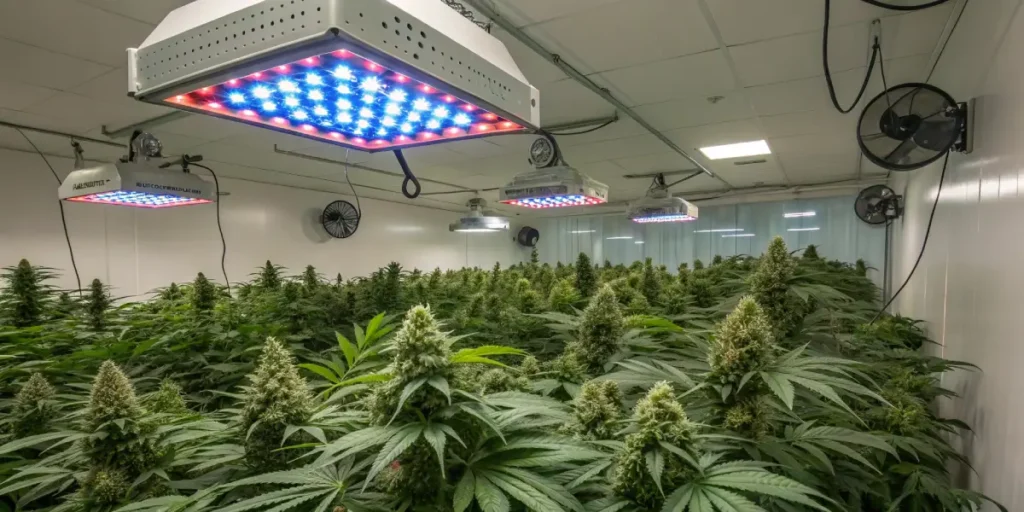
PAR Output: Ensuring Adequate Light Intensity
PAR (Photosynthetically Active Radiation) is a measure of the light that plants can use for photosynthesis. The best grow lights for marijuana will have a high PAR output, ensuring that your plants receive the intense light they need for robust growth.
- High PAR Levels: A grow light with a high PAR output ensures that your plants get enough energy to produce large, dense buds. However, it’s not just about having high PAR—it’s about having the right amount of PAR for your specific grow space. Too much light can cause light burn, while too little can lead to weak, leggy plants.
- Even Light Distribution: A good grow light will distribute PAR evenly across the entire coverage area, avoiding hotspots or weak spots. This ensures that all parts of your plants receive the same amount of light, leading to uniform growth and better overall yields.
Wattage and Energy Efficiency: Balancing Power and Cost
Wattage is another important factor to consider when choosing grow lights. It indicates how much power a light consumes and indirectly correlates with light intensity.
- Appropriate Wattage: The best wattage for your grow light depends on the size of your grow space. A general guideline is to have around 30-50 watts per square foot of grow space. However, this can vary based on the type of light and the specific needs of your plants.
- Energy Efficiency: While high wattage can deliver intense light, it also increases energy costs. The best grow lights for marijuana are those that strike a balance between power and efficiency. LED lights, for instance, are known for their high efficiency, delivering more light per watt than traditional HID lights.
Heat Management: Keeping Your Grow Room Cool
One of the challenges of using powerful grow lights is managing the heat they produce. Excessive heat can stress your plants, slow growth, and even cause damage.
- Low Heat Output: LED grow lights are particularly known for their low heat output, making them a great choice for small or confined grow spaces. They reduce the risk of heat stress on your plants and lower the need for extensive cooling systems.
- Effective Heat Dissipation: The best grow lights will have built-in heat sinks or fans to dissipate heat effectively. This ensures that the lights run cooler and last longer, while also maintaining a stable environment for your plants.
Durability and Lifespan: Investing in Quality
When you invest in a grow light, you want it to last. Durability and lifespan are key factors that determine the overall value of your purchase.
- Long Lifespan: LED grow lights typically have a longer lifespan than other types of lights, often lasting up to 50,000 hours or more. This makes them a cost-effective choice in the long run, even if the initial investment is higher.
- Build Quality: The best grow lights are built to withstand the rigors of a grow room environment, which can be humid and hot. Look for lights with sturdy construction, quality materials, and a good warranty to ensure they stand the test of time.
Flexibility and Adjustability: Tailoring Light to Your Plants
Flexibility is another important characteristic of a good grow light. The ability to adjust the light spectrum, intensity, and coverage can make a big difference in your grow results.
- Adjustable Spectrum: Some modern grow lights allow you to adjust the spectrum of light, switching between more blue or red light as needed. This flexibility lets you provide the optimal light for each stage of your plants’ growth.
- Dimmable Features: Dimmable lights give you control over the intensity of the light, which can be useful in preventing light stress during sensitive growth phases or when transitioning between growth stages.
- Modular Designs: Some grow lights offer modular designs that allow you to add more lights as your grow space or needs expand. This flexibility can save you money and space in the long run.
Coverage Area: Matching Your Grow Space
The coverage area of a grow light refers to the amount of space it can effectively illuminate. The best grow lights for marijuana will match your grow space in terms of size and shape.
- Appropriate Coverage: Make sure the grow light you choose can cover your entire grow space without leaving any plants in the dark. Different lights have different coverage areas, and using a light that’s too small can lead to uneven growth.
- Uniform Light Distribution: A good grow light will provide even coverage across its entire range, ensuring that all parts of your plants receive the same amount of light. This helps prevent weak spots and promotes uniform growth.
Ease of Use and Setup: Simplifying the Growing Process
For many growers, especially those new to the process, the ease of setup and use is a critical factor when choosing a grow light. A light that is complicated to install or difficult to operate can lead to frustration and potentially harm your plants if not set up correctly.
- Plug-and-Play Design: The best grow lights for marijuana often come with a plug-and-play design, making them easy to install without the need for additional equipment or complicated wiring. This is especially important for beginners who may not have experience setting up grow lights.
- Clear Instructions: A good grow light will come with clear, easy-to-follow instructions, ensuring that you can get your system up and running quickly and correctly. Look for lights that include detailed guides on setup, recommended height, and light schedules.
- User-Friendly Controls: Modern grow lights often feature intuitive controls, such as digital timers, dimmable settings, and remote control options, allowing you to easily adjust the light to meet your plants’ needs without constant manual intervention.
Compatibility with Grow Room Accessories
Your grow lights will likely be part of a larger system that includes fans, filters, and other grow room accessories. Ensuring that your lights are compatible with these other components is important for creating a cohesive and efficient grow environment.
- Ventilation Systems: Grow lights, especially those that produce a lot of heat, need to work well with your ventilation system. This helps to maintain optimal temperatures and prevents heat buildup, which can harm your plants.
- Reflective Materials: The best grow lights are designed to work with reflective materials commonly used in grow tents and rooms, such as Mylar. These materials help to maximize light efficiency by reflecting light back onto the plants, ensuring that no light is wasted.
- Automation Systems: If you’re using an automated grow room system, such as one that controls lights, humidity, and feeding schedules, your grow lights should be compatible with this system. Many modern lights can be integrated with smart home systems, allowing for remote monitoring and adjustments.
Common Pitfalls When Choosing Grow Lights and How to Avoid Them
To fully appreciate why selecting the best cannabis growing lights is so important, it’s crucial to grasp the fundamental role that light plays in the growth process. Light is the primary energy source for plants. Through photosynthesis, marijuana plants convert light into the energy they need to grow, develop buds, and produce cannabinoids. The quality, intensity, and duration of light your plants receive directly affect their growth rate, health, and yield.
Overestimating Light Intensity Needs
It’s a common misconception that more light always equals better growth. However, too much light can actually harm your plants, leading to light burn and stressing the plants.
- Signs of Light Burn: Watch for signs of light burn, such as bleached or yellowing leaves, particularly near the tops of your plants. If you see these signs, raise your lights or reduce the intensity if possible.
- Proper Distance: Ensure your grow lights are positioned at the correct distance from the plant canopy. Each type of light has an optimal distance, and exceeding this can either deprive your plants of necessary light or expose them to too much.
Ignoring the Importance of Light Spectrum
Some growers focus too much on the intensity of light and overlook the importance of a balanced light spectrum. As discussed earlier, different wavelengths are crucial for different stages of growth.
- Balanced Spectrum: Choose lights that offer a full spectrum or those that allow you to adjust the spectrum as needed. This ensures that your plants receive the right type of light at the right time, which is essential for healthy growth and high yields.
- Supplemental Lighting: In some cases, you may need to supplement your primary grow lights with additional lights that provide specific wavelengths. For example, adding UV or far-red lights can boost certain aspects of plant growth and potency.
Not Considering the Heat Output
Heat management is a critical aspect of using grow lights effectively. Excessive heat can stress your plants, lead to nutrient deficiencies, and even cause irreversible damage.
- Heat Dissipation: Look for lights that have built-in cooling systems, such as fans or heat sinks, to manage heat output. This is especially important for high-intensity lights like HID systems, which can generate significant amounts of heat.
- Room Ventilation: Ensure that your grow room is properly ventilated to handle the heat produced by your lights. Inadequate ventilation can lead to hot spots and uneven temperatures, which can negatively impact your plants.
Choosing the Wrong Size Light for Your Grow Space
Another common mistake is choosing a grow light that doesn’t match the size of your grow space. A light that’s too small won’t provide adequate coverage, while one that’s too large can waste energy and produce too much heat.
- Coverage Area: Measure your grow space carefully and choose a light that provides even coverage across the entire area. Keep in mind the shape of your space as well—rectangular lights might be more effective in certain setups than square lights, depending on your grow tent or room dimensions.
- Modular Systems: Consider using modular lighting systems that allow you to add or remove lights as needed. This can give you flexibility as your grow operation evolves or if you expand your grow space.
Neglecting the Importance of Durability
Durability is often overlooked when selecting grow lights, but it’s a crucial factor that determines the long-term success of your grow operation. Cheap or poorly made lights can fail unexpectedly, disrupting your grow cycle and potentially ruining your harvest.
- Quality Materials: Invest in lights made from high-quality materials that can withstand the humid, often challenging environment of a grow room. Look for lights with solid construction, durable housing, and components that are resistant to moisture and heat.
- Warranty and Support: A good grow light should come with a warranty that covers you in case of defects or early failure. Additionally, strong customer support can be invaluable if you run into issues or need help optimizing your setup.
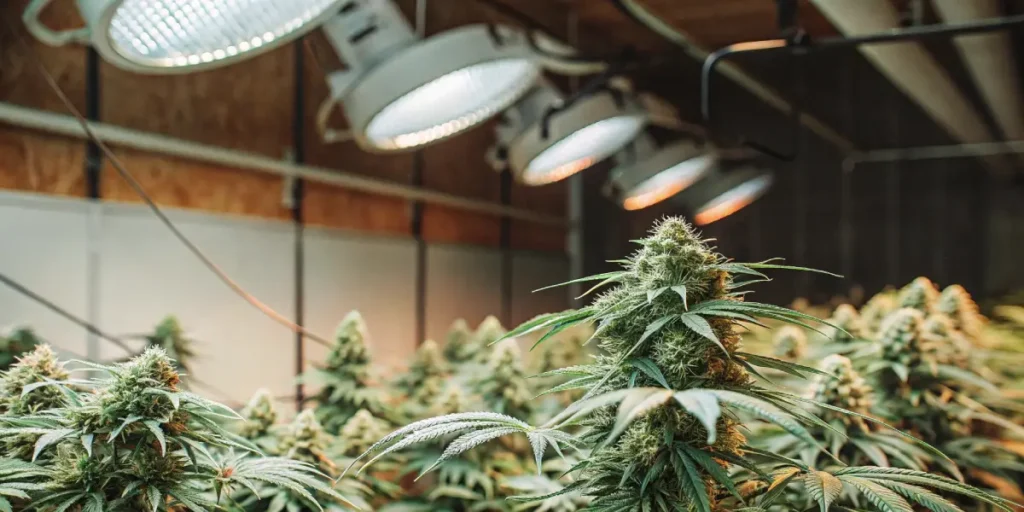
Maximizing the Efficiency of Your Grow Lights
Once you’ve chosen the best grow lights for marijuana, the next step is to ensure that you’re using them as efficiently as possible. Maximizing the efficiency of your lights can save you money on energy costs and improve the overall health and yield of your plants.
Optimizing Light Placement for Maximum Coverage
The placement of your grow lights is crucial to ensuring that all parts of your plants receive adequate light. Here are some tips for optimizing light placement:
- Even Distribution: Make sure your lights are evenly distributed across your grow space. This may require adjusting the height or angle of your lights or adding additional lights to cover any dark spots.
- Correct Height: The distance between your lights and the plant canopy is critical. Too close, and you risk light burn; too far, and your plants may stretch and become leggy. Most manufacturers provide guidelines for the optimal height of their lights, but you should also monitor your plants and adjust as needed.
- Use Reflective Surfaces: Reflective materials like Mylar can help increase light efficiency by reflecting light back onto your plants. Line the walls of your grow space with reflective material to ensure that no light is wasted.
Managing Light Schedules: How Long Should You Run Grow Lights Each Day?
The duration of light exposure, or photoperiod, is another key factor in cannabis cultivation. Different stages of growth require different light schedules:
- Vegetative Stage: During the vegetative stage, marijuana plants typically require 18 to 24 hours of light per day. This extended light period encourages rapid growth and the development of strong stems and leaves.
- Flowering Stage: To induce flowering, you’ll need to switch to a 12/12 light schedule—12 hours of light followed by 12 hours of complete darkness. This mimics the natural shortening of days that signals to the plant that it’s time to produce flowers.
- Consistency: Whatever light schedule you choose, consistency is key. Sudden changes in light schedules can stress your plants and negatively impact growth. Automated timers can help maintain a consistent light cycle.
Balancing Light and Heat: Preventing Light Burn
While providing sufficient light is essential, it’s equally important to manage the heat produced by your grow lights to prevent light burn and other heat-related issues.
- Monitor Temperatures: Use a thermometer to monitor the temperature at the canopy level, where the light intensity is highest. Ideally, the temperature should stay between 70°F and 85°F (21°C to 29°C), depending on the growth stage.
- Adjust Light Intensity: If you notice signs of light burn—such as bleached, yellowing leaves—reduce the light intensity or raise the lights higher above the plants. Dimmable lights can be particularly useful for fine-tuning light levels.
- Ensure Proper Airflow: Good airflow can help dissipate heat and prevent hot spots. Use fans to circulate air throughout your grow space and keep temperatures stable.
By carefully managing your grow lights and optimizing their efficiency, you can create an ideal environment for your marijuana plants to thrive, leading to higher yields and better-quality buds.
Preventing Common Mistakes with Grow Lights
Even with the best grow lights for marijuana, it’s possible to make mistakes that can negatively impact your plants. Awareness of these common errors and knowing how to avoid them can make a significant difference in your cultivation success.
Overexposure: Can Too Much Light Harm Your Plants?
One of the most frequent mistakes made by growers is overexposing their plants to light, under the assumption that more light will always result in better growth. However, too much light can be detrimental.
- Symptoms of Overexposure: Signs that your plants are receiving too much light include leaf burn (often visible as yellow or brown patches), wilting, and slowed growth. If you notice these symptoms, it’s crucial to act quickly by raising the lights or reducing the light intensity.
- Proper Light Intensity: Ensure that you’re using the right amount of light for the specific growth stage and the size of your grow space. Monitoring the distance between the light source and the plant canopy is key to preventing overexposure.
Underpowered Lights: How to Identify and Correct the Issue
On the flip side, using lights that are too weak for your grow space can result in underdeveloped plants with small, sparse buds.
- Symptoms of Insufficient Light: Plants that don’t receive enough light often become leggy as they stretch toward the light source. They may also exhibit slow growth and reduced bud formation. Leaves might become darker green as the plant tries to increase its chlorophyll production to capture more light.
- Choosing the Right Wattage: Make sure you’re providing enough light for your plants by selecting lights with adequate wattage and PAR output for your grow space. If you’re using LEDs, ensure they are high-quality and capable of delivering the necessary intensity.
- Supplemental Lighting: In cases where your primary grow lights are insufficient, consider adding supplemental lights to boost intensity, especially in areas that are shaded or receive less direct light.
Ignoring the Importance of Light Spectrum
Another common mistake is neglecting the specific light spectrum needs of marijuana plants at different stages of growth. As mentioned earlier, blue light is crucial during the vegetative stage, while red light is necessary during flowering.
- Inappropriate Spectrum: Using a light spectrum that is too heavy in either blue or red light at the wrong stage can hinder plant development. For example, too much blue light during flowering can result in smaller buds, while too much red light during vegetative growth can cause weak stems.
- Full Spectrum Lights: Investing in full-spectrum lights or lights with adjustable spectrums can help you provide the appropriate wavelengths for each stage of growth, optimizing plant health and yield.
Neglecting Light Schedule Consistency
Inconsistent light schedules can stress marijuana plants, leading to issues such as hermaphroditism (where plants produce both male and female flowers) and reduced yields.
- Maintaining Consistency: Use timers to ensure your grow lights turn on and off at the same time every day. This is especially important during the flowering stage, where plants require a strict 12/12 light/dark cycle to trigger and maintain flowering.
- Avoid Light Leaks: Ensure that your grow space is completely dark during the dark period of the flowering stage. Even small amounts of light can disrupt the photoperiod and stress your plants.

Ensuring Proper Maintenance and Longevity of Your Grow Lights
To get the most out of your grow lights and ensure they last as long as possible, proper maintenance is essential. This not only helps your lights perform optimally but also extends their lifespan, providing better value for your investment.
Regular Cleaning and Inspection
Dust and dirt can accumulate on your grow lights, reducing their effectiveness and potentially leading to overheating. Regular cleaning is a simple yet important task.
- Cleaning the Lights: Use a soft, dry cloth to wipe down the surface of the lights, removing dust and debris. For more thorough cleaning, use a damp cloth with a mild detergent, but ensure the lights are unplugged and completely cool before cleaning.
- Inspecting for Damage: Regularly inspect your lights for any signs of damage, such as cracks in the housing, frayed wires, or loose connections. Addressing these issues early can prevent more significant problems down the line.
Replacing Bulbs and Components
Even the best grow lights will eventually need replacement parts, especially if you’re using HID or fluorescent lights, which have a shorter lifespan than LEDs.
- Bulb Replacement: For HID and fluorescent lights, replace bulbs according to the manufacturer’s recommendations, typically every 6 to 12 months. Even if a bulb still lights up, its intensity and spectrum may have degraded over time, affecting plant growth.
- Upgrading Components: If your lights allow for component upgrades, such as new drivers or cooling fans, consider upgrading them periodically to improve performance and extend the lifespan of the light.
Monitoring Light Performance
Over time, the performance of grow lights can diminish. Monitoring their output ensures that your plants are still receiving the optimal amount of light.
- Using a PAR Meter: A PAR meter measures the intensity of light in the photosynthetically active range (400-700 nm). Regularly check the PAR output of your lights to ensure they’re still delivering the necessary intensity.
- Observing Plant Health: Ultimately, your plants are the best indicator of light performance. If you notice changes in growth patterns, reduced yields, or other signs of stress, it might be time to assess the condition of your grow lights.
FAQs
Why are grow lights important for marijuana cultivation?
Grow lights are essential for indoor marijuana cultivation because they provide the energy needed for photosynthesis, driving plant growth, bud development, and cannabinoid production. The right light spectrum and intensity directly impact plant health, yield, and potency, making the choice of grow lights a critical factor in successful cannabis growing.
What type of grow light is best for marijuana plants?
The best grow lights for marijuana plants typically offer a full light spectrum (blue and red wavelengths) with high PAR output and energy efficiency. Modern LED grow lights are highly recommended due to their adjustable spectrum, low heat output, long lifespan, and cost-effectiveness. Choosing the right light depends on your grow space and specific cultivation goals.
How can I prevent light burn on marijuana plants?
To prevent light burn, monitor the distance between your grow lights and the plant canopy, keeping temperatures between 70°F and 85°F. Use dimmable lights to adjust intensity and avoid overexposure. Watch for symptoms like yellowing or bleached leaves and ensure proper airflow with fans to manage heat and maintain an even temperature in the grow space.


